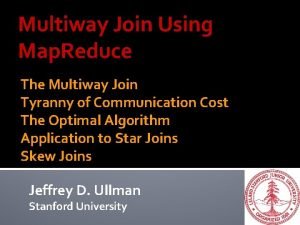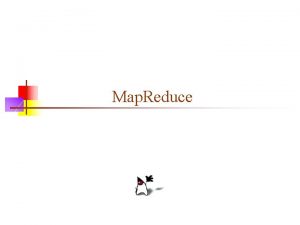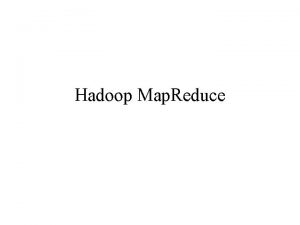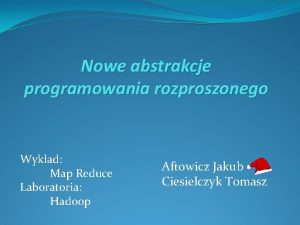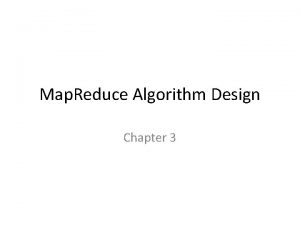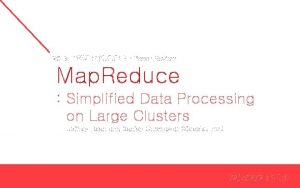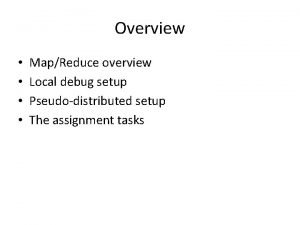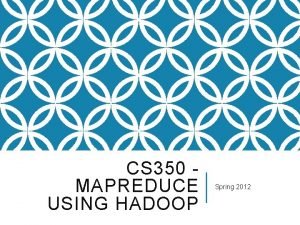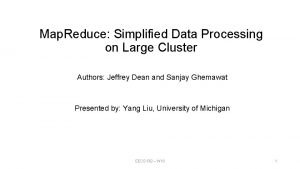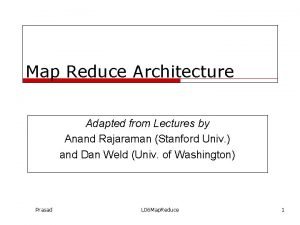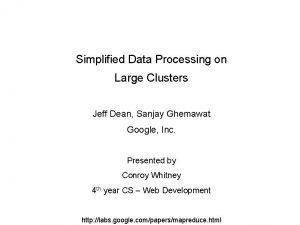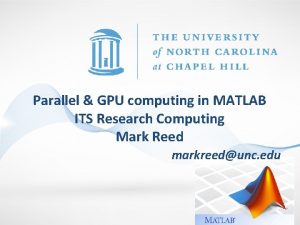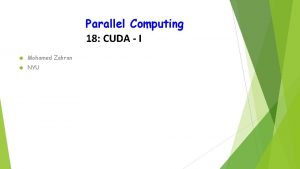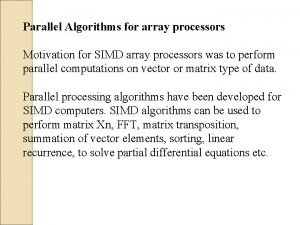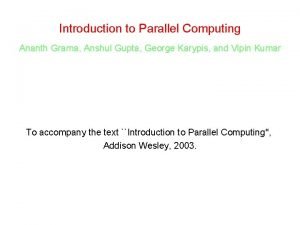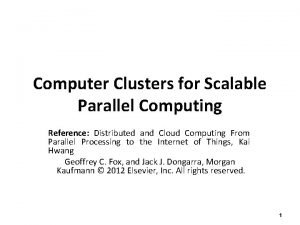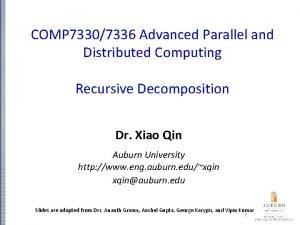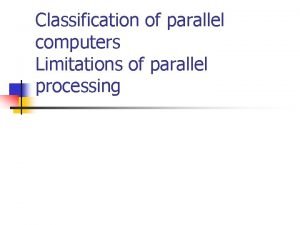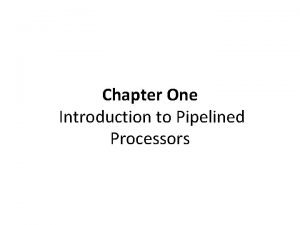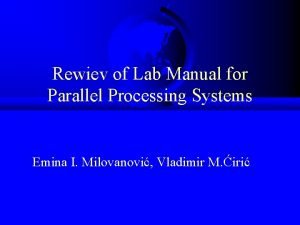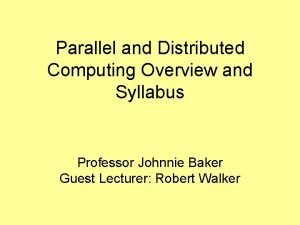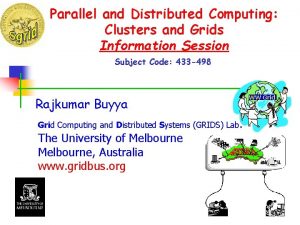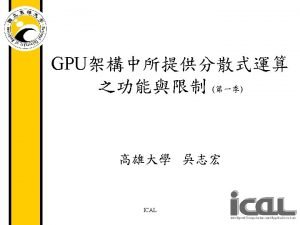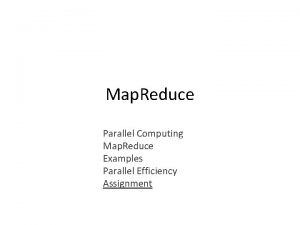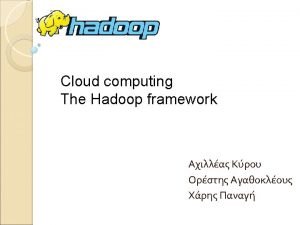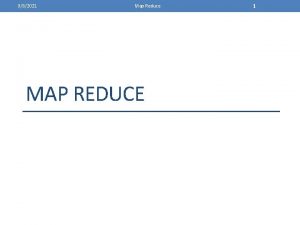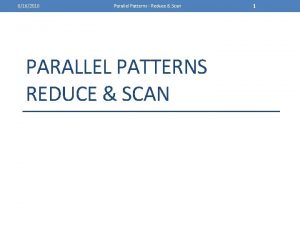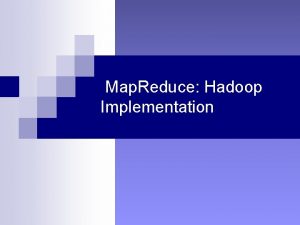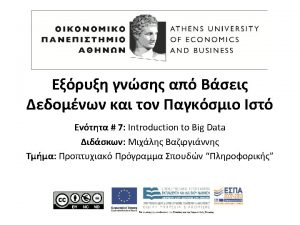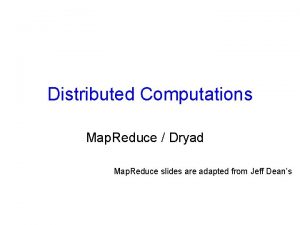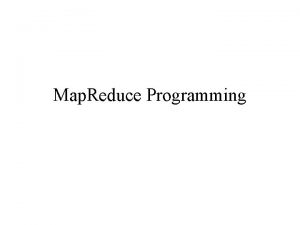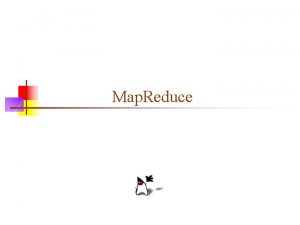Map Reduce Parallel Computing Map Reduce Examples Parallel































- Slides: 31

Map. Reduce Parallel Computing Map. Reduce Examples Parallel Efficiency Assignment

Parallel Computing • Parallel efficiency with p processors • Traditional parallel computing: – focus on compute intensive tasks – often ignores disk read and write – focus on inter-processor n/w communication overheads – assumes a “shared-nothing” model

Parallel Tasks on Large Distributed Files • Files are distributed in a GFS-like system • Files are very large – many terabytes • Reading and writing to disk (GFS) is a significant part of T • Computation time per data item are not large • All data can never be in memory, so appropriate algorithms are needed

Map. Reduce • Map. Reduce is both a programming model and a clustered computing system – A specific way of formulating a problem, which yields good parallelizability esp in the context of large distributed data – A system which takes a Map. Reduce-formulated problem and executes it on a large cluster – Hides implementation details, such as hardware failures, grouping and sorting, scheduling …

Word-Count using Map. Reduce Problem: determine the frequency of each word in a large document collection

• Map: • Reduce: document -> word-count pairs word, count-list -> word-count-total

General Map. Reduce Formulation of a Problem Map: – Preprocesses a set of files to generate intermediate key-value pairs – As parallelized as you want Group: – Partitions intermediate key-value pairs by unique key, generating a list of all associated values Reduce: – For each key, iterates over value list – Performs computation that requires context between iterations – Parallelizable amongst different keys, but not within one key

Map. Reduce Parallelization: Execution Shamelessly stolen from Jeff Dean’s OSDI ‘ 04 presentation http: //labs. google. com/papers/mapreduce-osdi 04 -slides/index. html

Map. Reduce Parallelization: Pipelining • Finely granular tasks: many more map tasks than machines – Better dynamic load balancing – Minimizes time for fault recovery – Can pipeline the shuffling/grouping while maps are still running • Example: 2000 machines -> 200, 000 map + 5000 reduce tasks Shamelessly stolen from Jeff Dean’s OSDI ‘ 04 presentation http: //labs. google. com/papers/mapreduce-osdi 04 -slides/index. html

MR Runtime Execution Example • The following slides illustrate an example run of Map. Reduce on a Google cluster • A sample job from the indexing pipeline, processes ~900 GB of crawled pages

MR Runtime (1 of 9) Shamelessly stolen from Jeff Dean’s OSDI ‘ 04 presentation http: //labs. google. com/papers/mapreduce-osdi 04 -slides/index. html

MR Runtime (2 of 9) Shamelessly stolen from Jeff Dean’s OSDI ‘ 04 presentation http: //labs. google. com/papers/mapreduce-osdi 04 -slides/index. html

MR Runtime (3 of 9) Shamelessly stolen from Jeff Dean’s OSDI ‘ 04 presentation http: //labs. google. com/papers/mapreduce-osdi 04 -slides/index. html

MR Runtime (4 of 9) Shamelessly stolen from Jeff Dean’s OSDI ‘ 04 presentation http: //labs. google. com/papers/mapreduce-osdi 04 -slides/index. html

MR Runtime (5 of 9) Shamelessly stolen from Jeff Dean’s OSDI ‘ 04 presentation http: //labs. google. com/papers/mapreduce-osdi 04 -slides/index. html

MR Runtime (6 of 9) Shamelessly stolen from Jeff Dean’s OSDI ‘ 04 presentation http: //labs. google. com/papers/mapreduce-osdi 04 -slides/index. html

MR Runtime (7 of 9) Shamelessly stolen from Jeff Dean’s OSDI ‘ 04 presentation http: //labs. google. com/papers/mapreduce-osdi 04 -slides/index. html

MR Runtime (8 of 9) Shamelessly stolen from Jeff Dean’s OSDI ‘ 04 presentation http: //labs. google. com/papers/mapreduce-osdi 04 -slides/index. html

MR Runtime (9 of 9) Shamelessly stolen from Jeff Dean’s OSDI ‘ 04 presentation http: //labs. google. com/papers/mapreduce-osdi 04 -slides/index. html

Examples: Map. Reduce @ Facebook • Types of Applications: – Summarization • Eg: Daily/Weekly aggregations of impression/click counts • Complex measures of user engagement – Ad hoc Analysis • Eg: how many group admins broken down by state/country – Data Mining (Assembling training data) • Eg: User Engagement as a function of user attributes – Spam Detection • Anomalous patterns • Application api usage patterns – Ad Optimization – Too many to count. .

SQL Join using Map. Reduce

Ha. Doop Map. Reduce (Yahoo!) Data is stored in HDFS (Hadoop’s version of GFS) or disk Hadoop MR interface: 1. 2. The fm and fr are function objects (classes) Class for fm implements the Mapper interface Map(Writable. Comparable key, Writable value, Output. Collector output, Reporter reporter) 3. Class for fr implements the Reducer interface reduce(Writable. Comparable key, Iterator values, Output. Collector output, Reporter reporter) Hadoop takes the generated class files and manages running them

Pig Latin and Hive: MR Languages • Pig Latin – Yahoo! • Hive - Facebook

Example using Pig Find sessions that end with the “best” page. Visits Pages url time url pagerank Amy www. cnn. com 8: 00 www. cnn. com 0. 9 Amy www. crap. com 8: 05 www. flickr. com 0. 9 Amy www. myblog. com 10: 00 www. myblog. com 0. 7 Amy www. flickr. com 10: 05 www. crap. com 0. 2 Fred cnn. com/index. htm 12: 00 . . . user . . .

In Pig Latin Visits = load ‘/data/visits’ as (user, url, time); Visits = foreach Visits generate user, Canonicalize(url), time; Pages = load ‘/data/pages’ as (url, pagerank); VP = join Visits by url, Pages by url; User. Visits = group VP by user; Sessions = foreach User. Visits generate flatten(Find. Sessions(*)); Happy. Endings = filter Sessions by Best. Is. Last(*); store Happy. Endings into '/data/happy_endings';

Pig Latin vs. Map-Reduce • Map-reduce welds together 3 primitives: process records create groups process groups a = FOREACH input GENERATE flatten(Map(*)); b = GROUP a BY $0; c = FOREACH b GENERATE Reduce(*); • In Pig, these primitives are: – explicit – independent – fully composable • Pig adds primitives for: – filtering tables – projecting tables – combining 2 or more tables more natural programming model optimization opportunities

Example cont. Find users who tend to visit “good” pages. Load Visits(user, url, time) Load Pages(url, pagerank) Transform to (user, Canonicalize(url), time) Join url = url Group by user Transform to (user, Average(pagerank) as avg. PR) Filter avg. PR > 0. 5

Load Visits(user, url, time) Load Pages(url, pagerank) (Amy, cnn. com, 8 am) (Amy, http: //www. snails. com, 9 am) (Fred, www. snails. com/index. html, 11 am) (www. cnn. com, 0. 9) (www. snails. com, 0. 4) Transform to (user, Canonicalize(url), time) Join url = url (Amy, www. cnn. com, 8 am) (Amy, www. snails. com, 9 am) (Fred, www. snails. com, 11 am) (Amy, www. cnn. com, 8 am, 0. 9) (Amy, www. snails. com, 9 am, 0. 4) (Fred, www. snails. com, 11 am, 0. 4) Group by user (Amy, { (Amy, www. cnn. com, 8 am, 0. 9), (Amy, www. snails. com, 9 am, 0. 4) }) (Fred, { (Fred, www. snails. com, 11 am, 0. 4) }) Transform to (user, Average(pagerank) as avg. PR) (Amy, 0. 65) (Fred, 0. 4) Filter avg. PR > 0. 5 (Amy, 0. 65)

Exercise (in groups) 1. Generate at least 50 K random sentences of max length 140 characters from a set of 20 -30 words – Challenge version: download at least 50 K tweets using Twitter’s APIs 2. Find all sets of sentences that are 90% similar to each other, i. e. 90% of the words match – Formulate using Map. Reduce and implement in parallel – Challenge version: use Google Scholar to find an efficient algorithm for the above (it exists) – Challenge ++: implement the above in parallel using MR (Use Hadoop on AWS)

Parallel Efficiency of MR • Execution time on single processor: • Parallel execution efficiency on P processors • Therefore is important leading to the need for an additional intermediate ‘combine’ stage

Word-Count using Map. Reduce Mappers are also doing a ‘combine’ by computing the local word count in their respective documents
 Conventional computing and intelligent computing
Conventional computing and intelligent computing Example of like and unlike parallel forces
Example of like and unlike parallel forces Map reduce join
Map reduce join Mapreduce types and formats
Mapreduce types and formats Map reduce word count
Map reduce word count Google map reduce
Google map reduce Java map reduce
Java map reduce Map reduce algorithm
Map reduce algorithm Document
Document Map reduce paper
Map reduce paper Map-reduce
Map-reduce Map reduce program
Map reduce program Map-reduce
Map-reduce Sherpamap
Sherpamap Mapreduce: simplified data processing on large clusters
Mapreduce: simplified data processing on large clusters Java map reduce
Java map reduce Lisp map reduce
Lisp map reduce Google map reduce
Google map reduce Matlab parallel computing gpu
Matlab parallel computing gpu Mohamed zahran nyu
Mohamed zahran nyu Associative array processing in parallel computing
Associative array processing in parallel computing Introduction to parallel computing ananth grama ppt
Introduction to parallel computing ananth grama ppt Parallel computing toolbox
Parallel computing toolbox Computer clusters for scalable parallel computing
Computer clusters for scalable parallel computing Recursive decomposition in parallel computing
Recursive decomposition in parallel computing Cloud computing lecture
Cloud computing lecture Limitations of parallel computing
Limitations of parallel computing Handler classification
Handler classification Parallel computing lab manual
Parallel computing lab manual Parallel and distributed computing syllabus
Parallel and distributed computing syllabus Cluster in parallel and distributed computing
Cluster in parallel and distributed computing Cuda
Cuda


